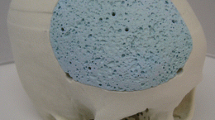Summary
This paper is to report a new method of reconstructing surgical skull defects with hydroxylapatite ceramics. The latter consist of Ca10(PO4)6(OH)2 which has a biological affinity with mammalian bone minerals. The author has designed two cranioplastic materials using hydroxylapatite ceramics: apatite buttons for burr hole skull defects and apatite granules for linear skull defects. The bone defects during 100 cases of standard craniotomy were successfully reconstructed with these materials with satisfactory cosmetic results. Hydroxylapatite ceramics are characterized by the excellent biocompatibility and biostability with a resultant bony fusion.
Similar content being viewed by others
References
Alesch F, Bauer R (1985) Polyacril prosthesis for cranioplastytheir production in silicon rubber casts. Acta Neurochir (Wien) 77: 68–71
Beumer J III, Firtell DN, Curtis TA (1979) Current concepts in cranioplasty. J Prosthet Dent 42: 67–77
Denissen HW, De Groot K, Makkes P Ch, Van Den Hooff A, Klopper PJ (1980) Tissue response to dense apatite implants in rats. J Biomed Mater Res 14: 713–721
Elikins CW, Cameron JE (1946) Cranioplasty with acrylic plates. J Neurosurg 3: 199–205
Griss P, Heimke G, Andrian-Werburg H, Krempien B, Reipa S, Lauterbach HJ, Hartung HJ (1975) Morphological and biomechanical aspects of Al2O3 ceramic joint replacement. Experimental results and design considerations for human endoprostheses. J Biomed Res Symp 6: 177–188
Grote JJ, Kuypers W, De Groot K (1981) Use of sintered hydroxylapatite in middle ear surgery. ORL 43: 248–254
Kobayashi S, Sugita K, Matsuo K, Inoue T (1981) Reconstruction of the sellar floor during transsphenoidal operations using alumina ceramic. Surg Neurol 15: 196–197
Körlof B, Nylén B, Rietz KA (1973) Bone grafting of skull defects. A report on 55 cases. Plast Reconstr Surg 52: 378–383
Koyama T, Handa J (1986) Porous hydroxylapatite ceramics for use in neurosurgical practice. Surg Neurol 25: 71–73
Kyoshima K, Gibo H, Kobayashi S, Sugita K (1985) Cranioplasty with inner table of bone flap. J Neurosurg 62: 607–609
Ogiso M, Kaneda H, Arasaki J, Tabata T, Hidaka K (1982) Epithelial attachment and bone tissue formation on the surface of hydroxylapatite ceramics dental implants. In: Winter GDet al (eds) Biomaterials. John Willy and Sons Ltd, USA, pp 59–64
Okumura T, Oda Y, Mori K, Uchida Y, Morimoto M, Kamimura Y, Seike M, Murata T (1984) Alumina ceramic (Bioceram) as the cranioplastic material. Experimental study and application in cranioplasty. Neurol Surg 12: 246–252
Psillakis JM, Nocchi VLB, Zanini SA (1979) Repair of large defect of frontal bone with free graft of outer table of parietal bones. Plast Reconstr Surg 64: 827–830
Yamaki T, Odake G, Horikawa Y, Suzuki K, Fujimoto M, Naruse S, Yano I, Ota T, Toyama M (1978) Clinical and experimental study of heat-cured methyl methacrylate for cranioplasty. Neurol Med Chir (Tokyo) 18: 323–329
Author information
Authors and Affiliations
Rights and permissions
About this article
Cite this article
Yamashima, T. Reconstruction of surgical skull defects with hydroxylapatite ceramic buttons and granules. Acta neurochir 90, 157–162 (1988). https://doi.org/10.1007/BF01560572
Issue Date:
DOI: https://doi.org/10.1007/BF01560572




